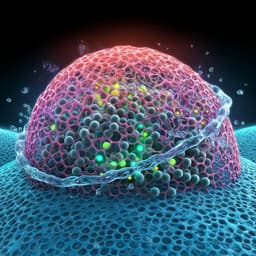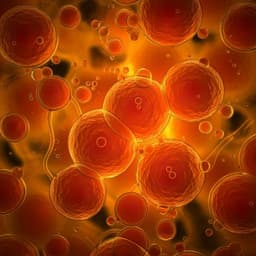
Physics
Frustrated self-assembly of non-Euclidean crystals of nanoparticles
F. Serafin, J. Lu, et al.
This groundbreaking research by Francesco Serafin, Jun Lu, Nicholas Kotov, Kai Sun, and Xiaoming Mao unveils an analytic theory for the self-assembly of polyhedral nanoparticles. It explores how geometrical frustration and interparticle interactions enable the creation of complex structures, such as highly pure helicoidal ribbons from tetrahedral nanoparticles. This innovative framework holds promise for advancing technologies requiring customizable optical activity.
~3 min • Beginner • English
Introduction
The paper addresses how simple polyhedral nanoparticles can self-assemble into complex, ordered three-dimensional structures despite intrinsic geometric frustration and competing interactions. Most polyhedra cannot tile Euclidean 3D space without gaps or overlaps, creating unavoidable elastic stress during face-to-face binding. Additionally, charged nanoparticles experience electrostatic repulsion that competes with attractive van der Waals, hydrogen-bonding, and coordination interactions. The authors propose that the thermodynamic ground states of such assemblies correspond to perfect non-Euclidean crystals in curved spaces (e.g., spherical 3-space), which serve as reference metrics for constructing an elastic energy functional in real Euclidean space. Because surface energies are relatively low and repulsions suppress bulk growth, self-assembly often arrests into low-dimensional morphologies (sheets, ribbons, bundles). The study focuses on tetrahedral CdTe nanoparticles coated with chiral ligands (L- or D-cysteine) that assemble into enantiopure helicoidal ribbons, aiming to explain formation pathways and provide a tunable control parameter (electrostatics) for morphology.
Literature Review
Prior work shows: (1) polyhedral nanoparticles exhibit diverse shapes and assemble into complex structures under attractive interactions; (2) most polyhedra do not tile Euclidean 3D space, but can form perfect packings (regular honeycombs/polytopes) in curved spaces; (3) non-Euclidean crystals and curved-space approaches have elucidated structures such as Frank–Kasper phases, metallic glasses, blue phases in liquid crystals, hard-disk packings on curved manifolds, and nanoparticle superlattices; (4) geometric frustration is a powerful framework for understanding modulated and hierarchical assemblies; (5) kinetic pathways and rugged free-energy landscapes complicate simulations of nanoparticle assembly; (6) chiral self-assembly in amphiphiles and peptide systems produces twisted ribbons via different microscopic mechanisms (bond-level chirality vs polyhedral tiling frustration). This study builds on these insights, using the 600-cell tiling of the 3-sphere as a stress-free reference for tetrahedra and connecting it to experimentally observed nanoparticle helices.
Methodology
The authors formulate a continuum elastic theory for frustrated self-assembly of polyhedral nanoparticles using a curved-space reference crystal as the stress-free configuration. Total energy: E = E_elastic + E_repulsion + E_boundary + E_bind. - E_elastic captures elastic cost from incompatibility between the Euclidean metric of the assembled structure and the ideal reference metric of the non-Euclidean crystal; it is expanded quadratically in the strain with Lamé coefficients determined by ligand-mediated interactions and coordination bonds. - E_repulsion accounts for screened and long-range electrostatic repulsion of charged nanoparticles. - E_boundary describes surface energy of exposed faces. - E_bind is the binding energy released by NP–NP attachment. Two-step strategy: (1) select a slice M from the non-Euclidean crystal (determined by kinetic pathways, competition among all energy terms, and anisotropic stress build-up); (2) for given M, determine morphology by minimizing E_elastic + E_repulsion, as E_bind + E_boundary are fixed by the choice of M. Specialization to tetrahedral CdTe NPs with chiral ligands: - Reference crystal: the 600-cell, a regular tiling of S^3 by tetrahedra with minimal curvature, constructed from homochiral tetrahelices (Bernal spirals) arranged as linked rings (Hopf fibration). Chiral ligands bias the handedness of tetrahelices formed during assembly. - Coordinates (α, β, θ) parameterize the 600-cell; the reference metric depends only on α, with constant-α surfaces being flat tori (Bianchi). - Choice of slice M: a thin shell, one tetrahedron thick, bounded between two special toroidal surfaces Σ_N and Σ_S around the Clifford torus (mid-surface). This selection is motivated by experimental kinetic evidence (tetrahelices form first, then pack into ribbons), energetic arguments (repulsion favors sheets; surface energy favors smooth triangulated surfaces), and the presence of stress-free directions along tetrahelices. - Thin-shell expansion near the mid-surface defines reference first and second fundamental forms (a, b). The off-diagonal b favors pure twist about the tetrahelix axis, but a and b are incompatible in Euclidean embedding, encoding geometric frustration. - The mid-surface is treated as an elastic ribbon/sheet cut open along β and θ to avoid global topological constraints of S^3; the resulting sheet can extend to mesoscale while remaining thin relative to radius of curvature. - Minimization: Solve for actual first and second fundamental forms by minimizing stretching (and bending) energies with free boundary conditions, including electrostatics. The resulting equilibrium embedding is a helicoid whose handedness matches the ligand and tetrahelix chirality (RH for D-Cys; LH for L-Cys). - Electrostatic control: The pitch p of the helicoid depends on electrostatic parameters (NP surface charge density, Debye screening length set by ionic strength, and solvent dielectric constant). Experimental methods: Synthesis of 4.5 ± 0.42 nm CdTe NPs capped with chiral cysteine; assembly triggered by adding Cd2+ and varying water/methanol ratio; helices formed under light irradiation at room temperature, then purified. Characterization includes SEM, zeta potential, CD and extinction spectroscopy. Debye length and dielectric constants for solvent mixtures are calculated via standard formulas; FDTD simulations of CD spectra for helicoids with experimentally relevant dimensions and pitch (200–1600 nm) complement measurements.
Key Findings
- The theoretical framework based on non-Euclidean crystals (600-cell of tetrahedra on S^3) yields a continuum elastic model predicting helicoidal ribbon morphologies for assemblies of tetrahedral NPs with chiral ligands. - The predicted helicoid chirality matches the ligand/nanotetrahelix handedness (RH for D-cysteine, LH for L-cysteine), consistent with experiments showing high enantiopurity. - Electrostatic repulsion provides a practical tuning knob for morphology: the helicoid pitch increases with NP charge density, Debye screening length (controlled by ion concentration), and solvent dielectric constant; in experiments, changing water/methanol ratio and Cd2+ concentration modulates these parameters and hence the pitch. - The model predicts pitch independent of ribbon length and width in a repulsion-dominated bending regime; experiments show pitch tuning consistent with the theory’s qualitative linear trends. - Experimental helices are multi-layer stacks of single-tetrahedron-thick helicoids; measured thickness exceeds a single NP size, while width and length are orders 10^2–10^3 nm, validating the thin-shell approximation. - Chiroptical properties: both experiments and FDTD simulations show a monotonic increase of the circular dichroism (CD) peak wavelength with increasing pitch; simulations spanning pitch 200–1600 nm reproduce the experimental trend, with large CD amplitudes extending to near-IR, relevant for imaging and photonic applications. - The reference metric’s translational invariance along the chosen slice supports scalable assembly pathways: smaller sheet fragments can merge with preserved contact topology, contributing to high-yield formation of target helicoids observed experimentally.
Discussion
The findings demonstrate that geometric frustration inherent to polyhedral NP shapes, when referenced to perfect packings in curved space, can drive controlled self-assembly into complex morphologies in Euclidean space. By using the 600-cell as a reference metric and incorporating electrostatics, the model explains the emergence of helicoidal ribbons with enantiopure handedness selection directly coupled to ligand chirality via tetrahelical precursors. The dependence of pitch on electrostatic parameters provides experimental control routes through solvent composition, ionic strength, and NP surface charge. The theory connects thermodynamic ground-state physics in curved space to kinetically accessible, low-dimensional assemblies in flat space, clarifying why sheets and ribbons are favored and why growth can be scalable (due to translational invariance of the in-plane reference metric). The chiroptical signatures follow from geometry: pitch-tuned helicoids predictably shift CD peak wavelengths, aligning with experimental measurements and electromagnetic simulations. The framework is broadly relevant and suggests how other NP shapes may map to spherical or hyperbolic reference crystals to engineer targeted curved morphologies with functional optical responses.
Conclusion
The study introduces a general non-Euclidean crystal-based framework for predicting and controlling the self-assembly of polyhedral nanoparticles. Applied to tetrahedral CdTe NPs with chiral ligands, the model predicts enantiopure helicoidal ribbons whose pitch is tunable by electrostatics, in qualitative agreement with experiments and simulations, and exhibiting strong, tunable chiroptical responses. This approach opens a design space where NP shape and interactions inform ideal curved-space packings that guide morphologies in Euclidean space, enabling materials with customizable optical activity and potentially unique mechanical, acoustic, catalytic, and biological properties. Future research directions include: incorporating topological defects (disclinations) explicitly to lower effective curvature; extending the theory to other NP shapes and to hyperbolic/spherical tilings; exploring alternative slices (clusters, tubes, shells, hierarchical assemblies); and quantitatively coupling kinetics with the energetic selection of slices to predict yields and size distributions.
Limitations
- The model focuses on equilibrium morphology determination for a given slice M and treats selection of M only qualitatively; a full non-equilibrium statistical mechanics treatment of kinetic pathways is deferred. - Disclinations and other topological defects are not explicitly modeled, though their role in reducing effective curvature and stress is discussed; real assemblies likely contain a distribution of defects. - Continuum approximation: nanoparticles and ligand bridges are treated as a homogeneous elastic medium; discrete effects and polydispersity are coarse-grained. - Some quantitative relations (e.g., exact pitch formula) are presented at scaling/qualitative level; comparisons emphasize qualitative agreement rather than precise parameter-free fits. - Global topology of the curved-space reference (S^3) is not imposed on the Euclidean assembly; the model relies on local reference order and cutting to sheets, which may neglect finite-size and boundary-specific effects.
Related Publications
Explore these studies to deepen your understanding of the subject.







